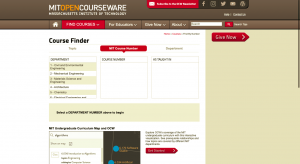This chapter was refreshing for me. New knowledge around copyright and usage of material online. The tools to avoid any legality issues are right there for us to use, unfortunately they are not very accessible. This is the first time I had learned about the functionality of advanced google searches, specifically around making sure your searches can yield reusable material.
The Differences
The term OER stands for an open educational resource. This means publicly available educational materials for folks to access. There are differences between online educational content and openly licensed educational content. For starters, openly licensed educational resources are generally allowed to be freely used.
Massachusetts Institute of Technology I had no prior knowledge that MIT had coursework available for the public. I compared its course directory and strengths, using the faculty guide for evaluation. It’s relevant depending on what you’re looking for in the directory. It is also large enough that you will most likely find the right course, and the accuracy is dependent on the users search. Because it comes from a reputable institution the information is well put together, the production quality is the same standard as other intuitions, comparable to the university of Victoria’s Summon 2.0 search tool, for example (see Figure 1). It had diverse interactivity, through PDF’s and videos, even old assignments to work on.
Personal use and review
I specifically chose Spanish and it showed me Spanish courses from level one up to six. It had a multitude of video clips and even articles and other tax course packs and assignments because I had prior knowledge of how to navigate these university directories it was quite similar the interface was easy enough for me to navigate. The template is straightforward, and I would definitely engage with some of the other courses such as French, or intermediate Spanish classes. just cut and dry type in what you’re looking for and it will show you what is within the directory and also what new courses are added in terms of licensing, MIT is one of the most reputable colleges in North America, all of the courses have been taught at the school at one point or another. Some of these courses date back to 2004. In closing this Open courseware from MIT is extremely useful. I recommend it to anyone who may not have the means to pay for university courses or, wants to explore other faculties. This resource is valuable, and I commend the institution that created an opportunity for public access and learning. My only criticism is that this tool, and others like it, are not common knowledge. If there was a way to make this information more available. In addition, formatting of various ways of learning, the audio is there, but with these online courses the interface is not always accommodating to those who require different methods of learning, or live with diverse-abilities.

Figure 1. Courseware class directory.